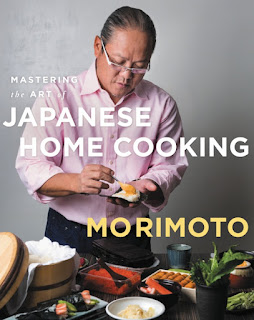Like anything, a solid knowledge and skill base builds a foundation and unclouds vision. That's what (Iron) Chef Masaharu Morimoto offers up in his new cookbook, Mastering the Art of Japanese Home Cooking. While admitting that this book does not, and could not, contain "every dish in the Japanese grandmother's repertoire", it does feature ones that he whip up in your kitchen if he could...his favorites.
By reacquainting the home cook with dishes and sauces that have been poorly represented in restaurants and supermarket aisles over the years, as well as introducing new dishes, his goal is to make Japanese cooking as well-received as Mexican, Italian, and French are in American home kitchens.
I think Morimoto is well on his way to accomplishing that goal with this cookbook. The majority of the recipes have short, and more importantly—obtainable, recipe lists. Recipes are introduced and interspersed with personal memories and bits of history, which I believe helps the average home cook connect and understand the recipe better (at least that's what it does for me).
And like my favorite cookbooks out there, Mastering the Art of Japanese Home Cooking opens with an introduction from the author/chef. Don't skip this. Never skip this. If the recipes are the heart of the book, the introduction is the soul; reading it will help you understand how to embrace the rest of the book.
Mastering the Art of Japanese Home Cooking
author: Masaharu Morimoto
publisher: Ecco (November 8, 2016)
photos: Yes, beautiful ones!
hard cover:275 pages
chapters/sections: Dashi (The Easy, Essential Japanese Stock) | Gohan (Rice) | Supu (Soups) | Yaku (To Grill, Broil, and Sear) | Musu (To Steam) | Niru (To Simmer) | Itame Ru (To Stir-fry) | Men (Noodles) | Ageru (To Fry) | Ae Ru (To Dress) | Tsukeru (To Pickle)
fun features: Each chapter has an "introduction" page that features the Japanese name with the American translation, as well as a small anecdote regarding the topic of the chapter.
(a few of the many) recipes destined for my kitchen: Chahan (Japanese-style Fried Rice) | Tsukune No Teriyaki (Chicken Meatballs with Teriyaki Sauce) | Saki Shioyaki (Salt-Grilled Salmon) | Kaisen Yaki Udon (Stir-fried Udon Noodles with Seafood) | Homemade Udon Noodles | Supagetti No Teriyaki (Chicken Teriyaki Spaghetti) | Kaki Age (Shrimp and Vegetable Fritters)
about the author: Masaharu Morimoto was raised in Hiroshima and opened his first restaurant in Japan. After moving to the United States, he was executive chef at the highly acclaimed Nobu restaurant in New York City, then opened his namesake restaurant, Morimoto, in Philadelphia, which he later expanded to New York. Morimoto’s restaurants now include Wasabi by Morimoto in Mumbai and New Delhi and Morimoto Sushi Bar in Boca Raton, Florida, as well as others in Napa, Mexico City, Maui, and Waikiki. Morimoto appeared on the Japanese television show Iron Chef and the Food Network’s Iron Chef America. He is the author of Morimoto: The New Art of Japanese Cooking.
connect with the author: website | facebook | twitter | instagram
recipe(s) I have already tried: Green Beans with Sesame Dressing (Ingen no goma-ae)
author: Masaharu Morimoto
publisher: Ecco (November 8, 2016)
photos: Yes, beautiful ones!
hard cover:275 pages
chapters/sections: Dashi (The Easy, Essential Japanese Stock) | Gohan (Rice) | Supu (Soups) | Yaku (To Grill, Broil, and Sear) | Musu (To Steam) | Niru (To Simmer) | Itame Ru (To Stir-fry) | Men (Noodles) | Ageru (To Fry) | Ae Ru (To Dress) | Tsukeru (To Pickle)
fun features: Each chapter has an "introduction" page that features the Japanese name with the American translation, as well as a small anecdote regarding the topic of the chapter.
(a few of the many) recipes destined for my kitchen: Chahan (Japanese-style Fried Rice) | Tsukune No Teriyaki (Chicken Meatballs with Teriyaki Sauce) | Saki Shioyaki (Salt-Grilled Salmon) | Kaisen Yaki Udon (Stir-fried Udon Noodles with Seafood) | Homemade Udon Noodles | Supagetti No Teriyaki (Chicken Teriyaki Spaghetti) | Kaki Age (Shrimp and Vegetable Fritters)
about the author: Masaharu Morimoto was raised in Hiroshima and opened his first restaurant in Japan. After moving to the United States, he was executive chef at the highly acclaimed Nobu restaurant in New York City, then opened his namesake restaurant, Morimoto, in Philadelphia, which he later expanded to New York. Morimoto’s restaurants now include Wasabi by Morimoto in Mumbai and New Delhi and Morimoto Sushi Bar in Boca Raton, Florida, as well as others in Napa, Mexico City, Maui, and Waikiki. Morimoto appeared on the Japanese television show Iron Chef and the Food Network’s Iron Chef America. He is the author of Morimoto: The New Art of Japanese Cooking.
connect with the author: website | facebook | twitter | instagram
recipe(s) I have already tried: Green Beans with Sesame Dressing (Ingen no goma-ae)
Find more reviews and featured recipes from Mastering the Art of Japanese Home Cooking at the Japanese Home Cooking Party on the Book Club Cookbook website.
Connect with Book Club Cookbook: Website | Facebook | Twitter | Pinterest | Instagram
Connect with Harper Collins/Ecco: Facebook | Twitter | Pinterest | Instagram | Tumblr
Purchase the cookbook: Amazon
yield: serves 4

Green Beans with Sesame Dressing (Ingen no goma-ae)
prep time: 10 MINScook time: 3 MINStotal time: 13 mins
Freshly toasted sesame seeds spiked with soy sauce and mirin become a nutty, rich dressing for crunchy green beans. Perfect for picnics and bento boxes.
INGREDIENTS:
- 3 tablespoons sesame seeds
- kosher salt
- 2 cups trimmed, halved green beans
- 1 tablespoon Japanese soy sauce
- 1 tablespoon mirin (sweet rice wine)
- 1 teaspoon granulated sugar
INSTRUCTIONS:
- Put the sesame seeds in a small skillet, set it over medium heat, and toast, stirring and tossing frequently, until they're a few shades darker, 2 to 3 minutes. Transfer them to a bowl to cool.
- Pound the seeds in a mortar or buzz in a spice grinder until you have a slightly coarse powder. Set aside for now.
- Bring a small pot of water to a boil and season it with about 1 tablespoon salt. Prepare a bowl of ice water.
- Add the green beans to the pot and cook, stirring occasionally, until they're fully cooked but still have a slight crunch, about 3 minutes. Drain the beans, immediately transfer them to the ice water, and stir well. When the green beans are cool, drain and pat them dry.
- Combine the soy sauce, mirin, sugar, and reserved sesame powder in a bowl and stir to combine.
- Add the green beans and stir to coat them well. Mound the green beans on a plate and serve.
- Will keep, refrigerated, in an airtight container for one day.
-recipe from Mastering the Art of Japanese Home Cooking by Masaharu Morimoto; used with permission.
Created using The Recipes Generator
I received a complimentary copy of this book in exchange for my honest review.








